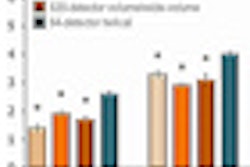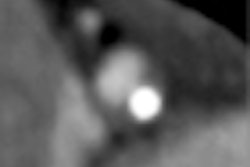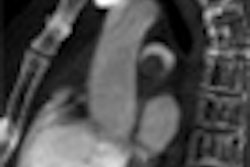The long-term risk of future cancers associated with CT scans has been under scrutiny for years, but those risks aren't remotely as serious as the risk of dying from the diseases CT is used to diagnose, concluded a study presented on Tuesday at the American Roentgen Ray Society (ARRS) meeting in Vancouver.
The risk from underlying disease overshadows risk from CT-induced malignancy by about 35-to-1 -- even in young adults who are most at risk from radiation, according to the retrospective four-year analysis by Dr. Robert Zondervan and colleagues from Massachusetts General Hospital, Brigham and Women's Hospital, and Dana-Farber Cancer Institute.
"Everyone was saying CT is a killer, so we wanted to see why these patients were getting scanned," Zondervan said in a telephone interview with AuntMinnie.com. "In this project, we're realizing that the risk of dying from why they're getting scanned is much higher than the risk of dying from radiation-induced cancer. That's not to say there shouldn't be a focus on radiation reduction, because of course there should be."
Those efforts represent the core of the study's secondary goal: identifying the top indications for CT. Identifying those indications could help clinicians determine where dose-reduction and scan-reduction efforts have the greatest chance of producing real benefits, Zondervan said.
Zondervan and colleagues Dr. Peter Hahn; Dr. Cheryl Sadow; Bob Liu, PhD; and Dr. Susanna Lee, PhD, analyzed the records of all patients ages 18 to 35 who underwent a chest or abdominopelvic CT from 2003 to 2007 in the three Boston hospitals. In all, the analysis covered 21,945 patients and 40,369 exams over the five-year period, including 13,888 abdominopelvic scans and 8,057 chest CT scans.
The most common chest CT indications were cancer, trauma, cardiac complaint, and respiratory complaints, Zondervan said. The most common abdominopelvic CT indications were abdominal pain, cancer, trauma, urinary tract disease, bowel-related complaint, and cardiopulmonary complaint.
Projecting cancer incidence
First, the authors projected the CT-induced cancer incidence rates of the sample patient population. They characterized patients according to how often they had been scanned: very rarely (1-2 scans), rarely (3-5), moderately (6-15), and frequently (> 15). The authors then estimated cancer incidence based on age and gender according to the 2006 Biological Effects of Ionizing Radiation (BEIR VII) report.
Among the 12 cases of radiation-induced cancer predicted by the BEIR VII method in the patient population, six were in the very rarely scanned category, two were in the rarely scanned category, three were in the moderate frequency category, and one was in the frequently scanned category, the authors reported.
"The majority of cancers are expected to arise in patients receiving one to two scans," Zondervan said. "That's not to say that they're at higher risk, but rather there are just so many of them with low-level risk that we expect to see the number of cancers to arise from that population rather than the frequently scanned.
It's the sheer numbers that make the difference, Zondervan said. For example, in the chest scan population, there were about 15,000 patients scanned once or twice versus about 50 with frequent scans -- hence the higher risk among patients with fewer scans.
Patient deaths
Next, the researchers measured actual patient deaths from the conditions they were being treated for when they received the CT scans. Follow-up periods were less than five years, and deaths were calculated based on Social Security Death Index data.
Actual patient mortality based on chest CT scan frequency
|
|||||||||||||||
| Mean follow-up = 4.2 ± 1.65 years |
Actual patient mortality based on abdominal CT scan frequency
|
|||||||||||||||
| Mean follow-up = 3.5 ± 1.8 years |
The mortality rates of the very rarely scanned young patients were surprisingly high: 2.7% for chest CT and 4.7% for abdominopelvic CT, Zondervan said. The rates are a reflection of the reality that young adults needing scans are inherently at higher risk than the population as a whole.
"We found up to 4.7% mortality from underlying disease in patients who had just one or two scans, compared to the risk of dying from radiation-induced cancer of something like 0.5%," he said. In other words, their underlying morbidity is more significant than their long-term radiation risk, he explained.
Risk from CT scanning vs. underlying morbidities
|
Cancer was the No. 1 cause of death in both the abdominal and chest populations, so for the paper "we actually removed the cancer population from the data to determine if the mortality rates had changed," he said. Surprisingly, they didn't change anything significantly.
Cardiopulmonary complaints were second to cancer as a cause of mortality in the abdominopelvic group. Trauma ended up being a relatively small percentage of deaths in both the chest and abdominal populations, he said.
"Most people think going to the ER you get two CT scans from a [moving vehicle accident] or something," he said. "Most people think trauma will account for a high percentage of deaths, but it doesn't."
Zondervan said he hopes the study will affect thinking about CT in two ways.
"We now have a list of common CT indications where people interested in radiation reduction can focus their efforts to have maximal impact, and also we now provide mortality rates for these patients showing that, yes, radiation reduction is very important, but also that these patients are at higher risk than the average person, even someone receiving just one scan," he said.
"So it's OK to use CT scanning: These patients are at risk, and the risk of dying from the underlying morbidity is much higher than the risk of dying from radiation-induced cancer," Zondervan said.
Lowering CT x-ray dose would proportionately decrease the predicted number of radiation- induced cancers, but dose reduction needs to occur in ways that do not result in greater radiologist uncertainty, Zondervan told AuntMinnie.com.



















